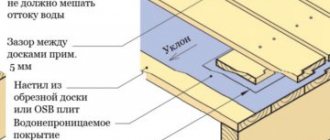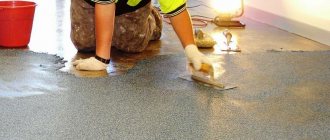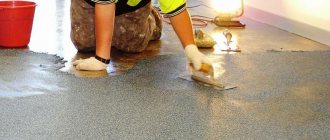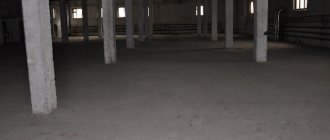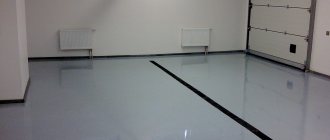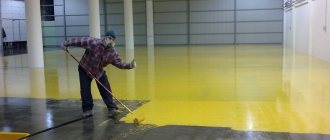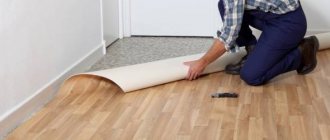Concrete is also an organism, but only a building one. Over time, he grows old and decrepit. But before starting its “treatment”, it is necessary to examine all the defects and determine the cause of their occurrence. The volume and type of upcoming repairs will largely depend on these factors.
The main causes of various defects are described in the article: “The main defects of a concrete floor and the reasons for their occurrence”
What is used to “completely” seal cracks in concrete?
Epoxy resin and repair compounds based on it
A very effective and cost-effective way to seal cracks in horizontal dry surfaces: floors, screeds, blind areas, concrete platforms for various purposes.
Advantages of the method:
- Low cost and quick drying;
- Reliably fixes the seams and keeps them from further expansion;
The following materials and tools will be required:
- Angle grinder equipped with a diamond disc “for concrete” for crack preparation;
- Dust removal devices;
- Spatula and containers for preparing the composition;
- Primer “for concrete”;
- Epoxy resin with hardener;
- Fine purified sand.
The sealing technology consists of preliminary “spreading” of the crack, removing the loose layer of concrete and removing dust. In this case, the size of the defect should increase by more than 5 mm in width. You should also cut transverse grooves in the concrete for power screeds in a format of length 100-150 mm, pitch 400 mm. Operations are performed with an angle grinder and a vacuum cleaner.
The next stage is soil treatment and insertion of repair brackets into the transverse grooves. Next, according to the attached instructions, a repair solution is prepared: epoxy resin, hardener, fine sand. Considering that the setting time of epoxy resin is about 10 minutes, filling the seam, transverse grooves and leveling the outer surface should be carried out as quickly as possible.
Popular compositions for repairs: Epoxy resin ED-16, ED-20 (hardener purchased separately) Russia; Epoxy 520 resin, Spolchemie, Czech Republic; composition UZIN KR 416, Germany; Repair Technokolla, (Sika), Italy (the most popular composition for repairing concrete cracks).
Pouring technology
You can make an epoxy self-leveling floor with your own hands in the same way as other types of self-leveling floors. The following article details the process step by step.
Preparing the base
The most reliable base for self-leveling floors is a cement-sand screed. There are options for pouring onto tiles or a wooden surface, however, the quality and reliability of such floors becomes less, and preparing the base will take more time and money.
The surface must be smooth and dry. If the floor humidity is more than 4%, then moisture entering the main layer of the coating will destroy it. If the concrete screed was made immediately before pouring the mixture, you must wait 4 weeks until the concrete gives up all excess moisture and gains the required strength. If you work with an old screed, you must first clean it of dirt and grease. It is also necessary to repair cracks and chips.
It is especially necessary to carefully level the surface so that there are no holes or bumps on it. Immediately before priming, it is important to remove dust and other debris, for example, using a vacuum cleaner.
Padding
The technology of self-leveling epoxy floors involves priming in two layers. After applying and completely drying the first one, it is important to make sure that there are no glossy areas on the surface. If there are any, they need to be cleaned and primed again.
When the first layer is completely dry, you need to apply the second and sprinkle it with quartz compound. Then the surface should be left until completely dry, and this will happen no earlier than in a day.
Base layer
It is applied in strips and evenly distributed using a squeegee and spatula. To ensure there are no air bubbles in it, you can roll it with a needle roller.
To avoid leaving marks on the floor surface, you need to wear paint shoes over regular shoes.
Finishing layer
After applying the base layer, about 2 days should pass. Before applying the finishing layer, you can create another one - a decorative one, which will be in harmony with the design of the room. With its help you can divide the room into zones. Then you can apply a finishing clear coat.
As you can see, the two-component self-leveling floor has a simple pouring technology. However, when working with it, it is very important to pay attention to details and carefully approach the issue of surface preparation.
Having completed all the work on pouring epoxy resin with high quality, you can get durable and reliable floors that will please the eye and fit harmoniously into the interior of the room.
© 2022 prestigpol.ru
Self-expanding cords and sealants
This is one of the most reliable, but quite expensive methods of concrete repair. Therefore, it is used mainly in swimming pool bowls, in underground parts of foundations and external surfaces of walls of buildings and structures.
Advantages of the method:
- The ability to select a material option for any defect;
- Complete tightness and durability;
- Possibility of installation in low ambient temperature conditions.
Required tools and materials:
- See the first two points of the previous method;
- Self-expanding repair: tape, cord or mat;
- Polyurethane sealant “for concrete”, mounting gun;
- Bench chisel, brush, paint brush, foam rubber.
The sealing technology is thorough, so before sealing cracks in concrete using a self-expanding material, carefully read the recommendations:
- Measurements are taken of the depth and width of the crack, based on the results of which an option for the type of self-expanding material is selected;
- The crack is widened and dusted using a grinder, chisel and vacuum cleaner;
- If the defect depth is up to 60 mm, you can use a self-expanding tape measuring 18x23 mm;
- Important! Self-expanding materials are not subject to caulking or other types of installation reinforcement;
- After installing the tape, cord or mat into the crack, the free space is filled with polyurethane sealant, and the protruding material is smoothed out with a spatula.
DIY epoxy resin floor
Epoxy for pouring
– a unique plastic material that creates a durable
coating
with a beautiful gloss.
The room is transformed - a stylish gloss appears, the poured floor
is comfortable for walking and does not wear out for a long time.
The material is excellent not only for residential areas - houses and apartments - but also production workshops, hospitals, train stations, shopping centers. How to pour
an epoxy resin floor with your own hands?
If you follow the step-by-step instructions, you will get an attractive interior detail and reliable protection for the ceiling.
Additives to concrete for self-healing of possible cracks in concrete
Russian engineers have developed a concrete additive that promotes the formation of hydrophobic crystals. The additive “works” only in a poured structure in contact with moisture.
By adding an additive to the concrete used to fill the pool bowl or foundation, the developer insures himself against the appearance of small and medium-sized cracks, which later turn into large problems.
At the moment, ONLY one produces this unique additive in Russia (Penetron Admix).
Advantages and disadvantages
Compared to other coatings, epoxy flooring has several advantages. Among them are the following:
- Easy to care for. Since the floors are seamless, there are no places where dirt would accumulate (as, for example, occurs in the seams between tiles or parquet). Thanks to the smooth surface, wet cleaning will not be difficult.
- Good waterproofing. The polymer solution is enough so that you don’t have to worry about laying the waterproofing layer.
- Resistant to temperature changes. This allows you to make epoxy floor coating even in bathhouses, where there are constant strong changes in temperature. Epoxy self-leveling floors will not deteriorate if the room in which they are poured is not heated during the cold season.
- Resistance to mechanical damage. If scratches or chips appear, they can be easily eliminated using a transparent composition.
- Resistance to chemical compounds.
- A wide range of design solutions allows you to create floors that fit perfectly into the interior of the entire room.
- Protection from the appearance of fungi, mold and other harmful microorganisms.
However, epoxy resin for self-leveling floors also has its disadvantages:
- The smoothness of the surface makes damage, scratches and chips, if any, very visible.
- High price. Often this work is carried out by a team of specialists, so this also requires funds.
- If dismantling is necessary, this will not be so easy to do due to the solidity of the surface.
- Despite the long operational period, the need to apply an additional layer of polymer coating will arise earlier.
Other methods for effectively sealing cracks in concrete structures
Effective sealing of cracks in highly loaded concrete structures is carried out by injecting synthetic resins with low viscosity into the defects.
To do this, diagonal holes are drilled along the defect at an angle towards the crack. Bushings are inserted into the resulting holes, through which the repair compound, resin, is injected using special equipment. This technology allows for high strength and durability.
The problem of repairing cracks in concrete at home is solved in the following way. A liquid cement paste is prepared, epoxy resin with a hardener and proprietary repair mixtures are added to it.
This composition can be used to eliminate cracks less than 4 mm wide. For defects larger than 4 mm, a proprietary composition is used, consisting of 1 part cement, 3 parts water, 3 parts sand and PVA glue.
Which epoxy resin to choose for flooring?
The nuances on which the choice of material depends are the use of the room:
- level of loads - pedestrian, automobile, shock, compression and tension;
- temperature conditions in the room, whether steam treatment will be carried out;
- possibility of ingress of water, oils, motor fluids, chemicals;
- vibrations;
- presence of highly flammable substances and equipment;
- requirements for aesthetics - interior design;
- type of premises - residential, industrial, public (apartment, workshop, store, sports ground, etc.);
- type of overlap.
Features of epoxy resin floors that
are important
to know:
- harder than polyurethane – high abrasion resistance;
- less elastic - not very suitable for moving floors, recommended for pouring onto a concrete slab;
- perfectly repel moisture and other types of liquids - motor, food, chemical;
- suitable for installation in heated buildings, but not outdoors;
- have high aesthetics - they look attractive, can be painted in any color, the ability to apply patterns, sparkles, and complex images.
Depending on the use of the room, choose the appropriate type of coating:
- Thin layer. Suitable for various rooms, poured in a layer of up to one millimeter, is not afraid of moisture, and can withstand constant foot traffic.
- Thick layer. Made in 2-3 millimeters, resistant to abrasion - for intense pedestrian loads (hotels, childcare centers, shopping centers, saunas, water parks).
- With the addition of quartz. It has enhanced strength and is suitable for areas with very high abrasion - train stations, airports and other public buildings where people constantly wear street shoes.
- Industrial. Suitable for use in industrial and warehouse buildings, garages, and parking lots. Areas of application: pharmaceuticals, food industry, electronics production, mechanical engineering, auto centers and workshops.
How to fill cracks
A simple and affordable option can be used if the depth of the defect does not exceed 0.5 mm. It is important to assess the condition of the metal part of the reinforced concrete structure. There should be no rust on its surface. If there are signs of corrosion, manual concrete injectors can be used. They quickly fill concrete spaces with minimal effort and expense.
If during a visual inspection traces of corrosion or areas of delamination of the concrete slab are found, parts of the damaged material must be removed. The reinforcement is cleaned manually or using a grinding machine. Experts recommend following all recommendations and not neglecting the cleaning of metal parts. Otherwise, the injection solution will harden incorrectly and the cracks will gradually increase in size.
There are several proven schemes for filling and restoring a concrete monolith:
- Vertical. They look for the lowest point and begin to inject to the upper extremity.
- Horizontal. Filling the crack with a cementitious composition is carried out simultaneously on each side. You need to move smoothly, from the central part to the edges.
- Ceiling. The injection technique is similar to the previous option. Epoxy resin is introduced using a similar method. This material has an increased level of viscosity, so the material will not flow out of the hole.
After filling is completed, the tubes are disconnected. Special plugs in the form of plugs are installed in the packers. The place for which restoration work was carried out must be protected with a durable film. It remains on the surface of the material until the applied composition hardens. On average, hardening takes 2-3 days.
Manufacturers
The list of popular repair compounds includes products from the following manufacturers:
Ceresit
The manufacturer Ceresit produces different types of building mixtures for concrete foundations. The Ceresit CX5 mixture is a restorative mixture, suitable for repairing concrete structures at high humidity. The product does not shrink significantly when hardened and used, and can withstand changes in temperature conditions. The coating is resistant to high humidity and reliably hides defects. The cost of the composition is high - about 2500-3000 per package of 25 kg.
The composition of Ceresit CN 88 is intended for leveling floor coverings and is durable. The product is laid out in a layer of 5-50 mm and can be used indoors and outdoors. The mass is quickly leveled, the surface can be used 6 hours after restoration. The product is wear-resistant, suitable for mechanized spraying, and environmentally friendly in composition.
The minimum layer thickness is no less than 35 mm; on the sound and heat insulating layers, the product is laid out with a thickness of no less than 45 mm. Can be used as a base for laying finishing material.
Penetron m500 bond mixture
Concrete repair compositions from the Penetron brand are dry mixes. The formula contains processed quartz sand, fine-grained Portland cement, polymer compounds to improve the elasticity of the product, and mineralized fiber fibers. The mixture must be diluted in the proportions of 170 g of water per 1 kg of powder. Laying the mass is carried out at a temperature of at least +5°C. The surface must be washed with clean water.
Blend Parade
Parad brand compositions are intended for urgent repairs of concrete structures; the coating thickness can reach 60 mm. Laying can be done at a temperature not lower than +5°C. The advantage of the product is the rapid setting of the composition and the high strength of the patch.
After 1 day, the strength of the layer reaches 20 MPa; after 1 month, the coating acquires a strength parameter of 70 MPa, the frost resistance level is F200.
The product is universal, suitable for different types of structures (anchors, foundations, joints, road slabs, hydraulic structures, drinking water tanks).
Emaco
Repair mortar for concrete floors Emaco brand Basf is used for structures of various levels of complexity. Emako N 5100 is suitable for minor deformations (cracks, chips). Products N 900 and N 5200 are suitable for eliminating defects of medium complexity (cracks, collapsed areas).
Products S 5400, S 488 are used to eliminate damage due to the corrosion process, closing cracks up to 40 mm. The company also offers compositions for damaged concrete surfaces with exposed reinforcement bars and large chips.
Birss Russia
The concrete repair mixture from the Birss brand is universal and can be used for surfaces of different levels of complexity. Products 28, 29, 30, 30N are applied to eliminate cracks and deformed coatings. Special products (30С1, 59С2 and 58С1) are intended for medium wear surfaces; mixtures 59S3, 59Ts, RSM, RBM, 600VRS are used in case of major damage to structures.
The compositions have frost-resistant characteristics, are used at sub-zero temperatures, have high strength of bonding of elements, have water-resistant characteristics, high density, and plasticity.
Consolid Bars
Products for surface restoration Consolit Bars are suitable for panels located vertically and on floor coverings; the mass quickly holds surfaces together, does not shrink, and has high adhesion. The product line includes self-leveling, thixotropic (for restoration of wall panels), finishing, waterproof and reinforcing mixtures. The cost of production is 800-1500 rubles. per package 30 kg.
Knauf
Products for concrete repair from the Knauf brand are environmentally friendly, do not contain toxic substances, are durable, provide surface waterproofing, and have water- and vapor-proof characteristics. The mixtures are sold in compact packages (5-6 kg). The products are universal and are used for external and internal repair work. The cost of packaging (5 kg) is 350-500 rubles.
Industry
Indastro products are universal and are used for repairs, restoration of structures on foundations, restoration of road surfaces, etc. The composition ensures strong joining of elements, is durable, wear-resistant, does not have strong shrinkage, is water-resistant, and frost-resistant.
Mapei (Italy)
The mixture from the Mapei brand ensures that restoration work can be completed in a short time, does not shrink during hardening, does not deform, and prevents abrasion of surfaces. The special SW series is suitable for reinforced concrete structures and is resistant to temperature changes, precipitation and moisture. After hardening, the coating layer acquires anti-corrosion properties and is suitable for waterproofing work.
The product price is about 850-1500 rubles.
Mount Crystal
Mountain Crystal products are intended for the reconstruction of concrete floor surfaces, reinforced concrete floors, walls lined with foam concrete and aerated concrete blocks. The mass is used to seal cracks and placed in areas of chips, holes, voids and traces of erosion. The product is suitable for restoring walls, floor coverings, and ceilings.
Siltek
The manufacturer Siltek offers a composition for repairing defects in surfaces and finishing seams between panels. The materials are frost- and water-resistant, quickly harden, durable, and wear-resistant. Reinforced microfibers are included in the formulas of some products. Products are certified.
The particle size in the mass reaches 2.5 mm, the thickness of the coating reaches 30 mm, after 3 days the strength of the layer reaches 15 MPa, after 28 days - 35 MPa. The product is suitable for use within 30 minutes after dissolving in water.
Why should you buy repair and restoration compounds for concrete from iPolymer?
The company not only independently produces polymer mixtures, but also engages in direct sales. Thanks to this approach, the company manages to maintain very reasonable prices for concrete repair compounds. The absence of intermediaries allows iPolymer clients not to overpay, while receiving certified high-quality products. There are discounts for wholesale buyers. The company's employees provide full information support to both existing and new clients. You can get advice on the company’s products, as well as place an order, by calling the numbers listed on the website.
Surface preparation
The instructions for the work regulations contain special requirements. Before introducing the sealing resin, it is important to be able to prepare the surface of walls and other reinforced concrete structures.
Preparation includes several important steps:
- Using a hammer drill, holes are drilled along the crack that has formed. They must be placed strictly in a checkerboard pattern. Directionality - side of the defect.
- Packers are inserted into the holes. These are small tubes that will help connect equipment to perform work.
- Connect the pump. It helps to serve the mixture quickly. If the holes are made correctly during the preparation process and the recommended requirements are met, the composition will be poured evenly and tightly into the cracks. The solution fills the voids. And the integrity and high quality of the monolithic pipe are restored.
It is important to note that to work with epoxy or polyurethane resin, it is necessary to strictly adhere to the concrete injection technology and the viscosity of the material. Spaces and cavities in concrete structures must not be filled under high pressure.
You may not guess with the amount of composition. If its content is excessive, the crack will increase in size. The concrete monolith will no longer be integral.
Repair with elastic sealant
An elastic sealant can also help seal cracks.
The most popular in this case is silicone glue - sealant. This sealant is used both for small cracks and for those whose width is quite large.
The repair process that requires the use of a sealant is no different from a repair that uses a concrete compound.
First you need to clean the crack from dirt, make grooves for better bonding of the material to the surface. When applying glue/sealant to the surface, it must also be moistened.
The sealant, unlike the cement mixture, dries in a short time, which makes this material much more convenient.
However, the sealant is noticeably more expensive, so not everyone can afford such repairs.
Recommendations for choosing repair and restoration compounds
A high-quality polymer repair composition must have high adhesion and minimal shrinkage. Important characteristics are the ability to quickly harden, ease of application, and the ability to eliminate defects such as peeling, cracks, voids, and traces of corrosion.
To select repair and restoration mixtures, it is recommended to follow the following tips:
1. Before purchasing, you should evaluate the extent of the damage and the level of load the structure is experiencing. The material from which the surface to be processed in the future is also important. For a better understanding, all parameters can be written down.
2. The second step involves selecting the appropriate type of mixture - a non-shrinking repair composition for concrete with fiberglass, high adhesion rates, in dry or cast form.
3. Other criteria include the degree of shrinkage, level of consumption, time for complete hardening, additional properties, for example, waterproofing.
4. Having decided on all the parameters, you can begin to review the manufacturers available on the market. You should compare the advantages and disadvantages of each product, study the conditions of storage and use, and analyze the price level.
5. At the last stage, you need to decide on a suitable manufacturer and calculate the volume of material required.
6. Important note - the quality of products is influenced not only by the manufacturer’s compliance with certain standards, but also by the correct storage of finished products.
Features of the waterproofing composition
To protect the structure from water penetration, it is necessary to use polyurethane. This is a material that has increased waterproofing properties.
This material is used for various jobs:
- filling joints and seams that appear in places where monolithic concrete is attached to other parts;
- processing of wet opening;
- high-quality and correct insulation of cracks and holes that occur in the sewer or water supply network.
Before purchasing a composition for the restoration and restoration of concrete pavement, you need to familiarize yourself with the advantages and features of each material. To restore the integrity of the slab, you can consult a specialist. He will tell you what material to choose and how to dilute the solution correctly.
Difficulties of the concrete repair process
Repair of concrete surfaces using mortar or dry mixtures is required when the reinforcement is exposed, the material is destroyed, or the surface cracks down to the crushed stone filler. In the absence of restoration work, the structure may collapse.
To restore the integrity of the surface, specialized mixtures are used that are characterized by plasticity, a high degree of adhesion, and strength.
Repairing concrete floor defects using epoxy mastic
Concrete is also an organism, but only a building one. Over time, he grows old and decrepit. But before starting its “treatment”, it is necessary to examine all the defects and determine the cause of their occurrence. The volume and type of upcoming repairs will largely depend on these factors.
The main causes of various defects are described in the article: “The main defects of a concrete floor and the reasons for their occurrence”


